Meet the guitar slingers tearing up the session scene in Los Angeles
The New Wrecking Crew are a breed of young, hungry and talented guitarists that have begun to make serious waves as guns for hire in 2019.

Ariana Powell
The Los Angeles session scene of 2019 is a long way from the halcyon 60s and 70s days of Tommy Tedesco, Carol Kaye and Bill Pitman, but it’s still a vibrant and exciting place where hotshot musicians get the opportunity to work with some of the biggest acts on the planet. Over the last few years, a quiet revolution has taken place, and a new contingent of young, hungry and talented guitarists have begun to make serious waves as guns for hire in the LA music world. Meet the key players in the New Wrecking Crew.
Arianna Powell
In Los Angeles, capable guitarists are a dime a dozen. Oftentimes, the most capable are also the least gainfully employed. To stand out in this business, you’ve got to be reliable, versatile, and most of all, persistent. Find your niche and make a decent noise. Some may cite luck as a key factor, but for Arianna Powell, luck has little to do with it. In her mind, it’s all about making connections and showing up.
“I have always involved myself in many different scenes, so I’ve been able to build up a good reputation with a large network of people,” she tells us. “Of course, it’s imperative to be the best musician you can be, but in order to work, you really need to be a reliable person that people what to spend time around.”
Since arriving on the LA scene, she’s worked hard to make herself a known quantity to prospective employers. She took every chance she could to play with any artist who would have her – and some of her biggest breaks have come from simply being in the right place at the right time. “Someone told me, ‘It’s not who you know, it’s who knows you,’ and it’s true. I met the guy who helped put me on my first tour with Nick Jonas sitting in at [famed LA Jazz Club] The Baked Potato playing a John Scofield tune with the house band.”
Powell hails from Pen Argyl, a Pennsylvania Slate Belt borough just a stone’s throw north of Allentown, the real-world setting for Billy Joel’s famous tune about blue-collar hardship and the decline of American industry. She comes to Los Angeles by way of Pittsburgh, where she played in a wedding band that happened to have an LA-based counterpart. It was through this chapter that she made her first connections out west, booking corporate and club gigs by reputation alone. “It was just a lot of making friends and connections by being out in the scene as much as possible and taking every chance to play that I could.”
Like so many, Arianna got her start with the guitar through her family. Her father, who was a folk fingerpicker, introduced her to the likes of Bob Dylan, Gordon Lightfoot and Ramblin’ Jack Elliott. As she grew up, her taste in music naturally extended outward to metal, ska and even jazz. “My tastes have always been varied, so in the early days I’d learn Norah Jones songs and Kirk Hammett solos in the same afternoon.”
She drew inspiration from female artists of the 90s and 00s – Alanis Morissette, Sheryl Crow and Gwen Stefani; later, she studied Jazz at Duquesne University, where she transcribed arrangements of Johnny Smith and Joe Pass while spending nights taking the stage with various bi-coastal pop and rock cover outfits.
Powell’s made a career for herself as a side woman backing big-name acts such as Nick Jonas, Chris Brown, Drake Bell and most notably, The Black Eyed Peas. She’s worked with Canadian producer/songwriter David Foster, played on American Idol and devotes some of her time to working with up-and-coming artists including Grammy Award-winning singer-songwriter Daya (also from PA) and 17-year-old Instagram star turned pop powerhouse AJ Mitchell. At the time of publishing, she’ll be winding down a radio promotional tour with singer and former The X Factor USA contestant, Rachel Crow.
As a guitarist in a predominantly pop-oriented scene, one might expect that demand for the instrument has waned in recent times, but Powell sees her role within a production as important as ever. “I’m there to add energy and life to tracks that do not have much guitar in the first place,” she says. It makes sense when you consider the current mode of pop production: the bulk of work takes place in software and keyboard and mouse are the instruments of choice for many popular artists. A ‘real’ instrument thrown in tends to breathe life into the mix.
While she’s no stranger to the studio, it’s the stage where she truly feels most comfortable. “I like playing for people and feeling their energy,” she confesses. “I feel more free.” Whether in a stadium or a theatre, Powell’s fleet-fingered technique never fails to impress. What’s more, she’s able to morph between fiery, fluid shredding to laid-back grooving, all while making a cohesive musical statement, which perhaps has something to do with the fact that she’s an avid blackjack player. “It’s important to choose parts and sounds that make an impact; what’s a set without a ripping guitar solo?”
Most often, you’ll find Arianna wielding a PRS or Suhr, but her favorite instruments in her collection are a Shell Pink Fender Custom Shop ’63 Telecaster Custom and her Gibson ES-339, which she usually plays through a Fender Twin or Hot Rod Deluxe.
These days, Arianna’s hard at work on two albums of her own: one of solo guitar arrangements and well as another that she calls “more song-centric”. For now, she’ll continue to be an active and positive participant in the LA scene. “[Los Angeles] has so many great artists and musicians who are genuinely good people. They work really hard to perform honest, unique music, while supporting themselves and their careers. I wish labels would invest in those people instead of Instagram models.”
Mason Stoops
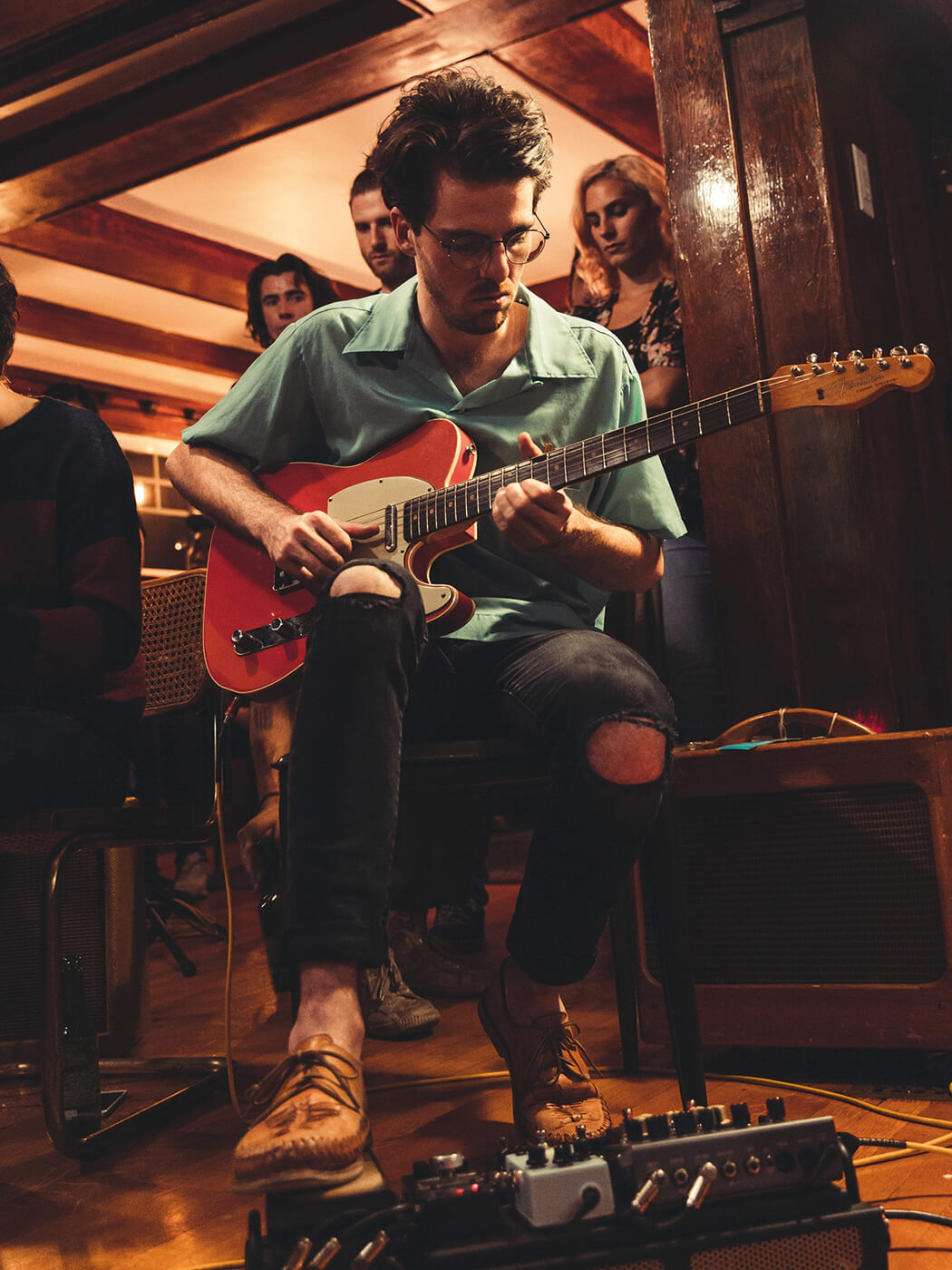
Perhaps more than any other player in Los Angeles, Mason Stoops embodies the phrase ‘wise beyond their years’. When you experience Mason’s prowess for the first time, you’ll swear you’re hearing a player many years his senior. Those controlled pedal-steel bends, roots-rock interludes and the throaty growl from his favoured Guyatone neck pickup all speak to a musician who isn’t content to simply cop the tones, but rather one who delights in knowing where it all came from.
Perhaps it’s best to think of Mason as a sort of musical archaeologist – the Indiana Jones of Mississippi John Hurt – because to him, it’s not just the notes or the style that’s important, it’s understanding the complex lineage of guitar music. What a given player was thinking and what their life was like matters just as much as tone and tempo. “If there’s an artist you really love, dig into that artist and find out which artists blew their mind. I’m a big believer in that. Backward is forward.”
As a kid growing up in Orange County just south of LA, music wasn’t always the plan. Chuckling into the phone, Mason recounts the winding path of his childhood career choices: “I wanted to be a pilot, or a race-car driver like my dad. Later, I wanted to go to military school, but my mom made me take a year of art school where I studied visual arts.” All of that melted away when one of his art-school teachers sent him down a musical rabbit hole, and soon enough, he was begging his mother for a bass guitar.
As it turns out, she didn’t know the difference, so he ended up with a guitar for Christmas. “I woke up early and went downstairs and saw the guitar there. I pressed down on the frets and thought, ‘Wow, this is hard.’” After a few minutes, he crept back to bed where he had an epiphany, a feeling that washed over him and never left. “It was a total physical feeling – a wave of calm. ‘That’s it, I play guitar now. This is your life.’”

Whether preternatural calling or mundane happenstance, it isn’t our place to say. What is certain is that a passion for guitar music was ignited within him and ever since that moment, he’s been fully immersed. Fugazi, Green Day and Rancid were major early influences and Mason goes on to cite Against Me! as his first-ever rock-show experience. While punk rock is still part of his musical vocabulary, it was the discovery of Chet Atkins that set Mason on his current path.
“I’d get to my lessons early and listen to my teacher practice, and it sounded like five guitars going at the same time… Eventually I figured out he was playing Chet Atkins.” Following a brief period of near-incessant pleading, his teacher finally agreed to show him Travis picking and fingerstyle technique, which lead him to roots music, early rock ’n’ roll, and country music. Page, Clapton, Beck, all of the usual suspects get name checked, but the two names Mason holds in the deepest reverence are Mark Knopfler and Hank Marvin.
Stoops credits Knopfler as his biggest influence, as well as the sole reason he doesn’t use a pick. “He didn’t use one, so I didn’t use one. I learned to do everything a pick could do without it.” Given his initial interest in the bass, this makes a lot of sense; there’s an inherent ‘thump’ and ‘groove’ to Mason’s playing, so his lack of a plectrum isn’t the liability in sessions one might think. In fact, it’s a personal goal of his for no one to know he’s not using a pick, especially on session dates. “If I’m in the other room, the producer doesn’t know.”
Hank Marvin is the reason Mason is so connected to the historical side of guitar playing. “I learned early on that he was Knopfler’s biggest hero. Page, Clapton, Beck – all of the original UK guitar heroes were influenced by Hank Marvin.” Knowing that, Stoops started combing through Marvin’s work and studied his technique intently. Along the way, he figured out just how precise that music really was, which he refers to as “Surf with a British accent.”
“What he was doing was shredding, well, given the time frame,” he waxes on, revealing that doing justice to the music hasn’t been easy. “It’s really challenging music to play right. It comes down to dynamics. It’s so particular and precise, but when you listen to it, it sounds effortless.”
Mason points out that musicians are products of their eras and that’s as true today as it was during Hank Marvin’s rise to fame. In attempting to learn the music properly, Mason found he had to eschew present-day techniques and change his frame of reference to match.
“In the 1950s and 60s, Hank Marvin developed a sound that came from his own musical ecosystem. When you’re a guitar player learning that music in 2019, it’s really hard to let go of all of your own influences. It’s so particular, so precise.” This obsession with The Shadows continues today, with Mason’s sporadic tribute performances of The Shadows’ music here in Los Angeles. And yes, he plays it all on the requisite Fiesta Red Stratocaster.
When asked about his philosophy on making it in the LA scene, Mason quotes the best piece of advice he’s ever been given: “Never be home.” Legendary composer Richard Gibbs laid that piece of wisdom on him years ago. For Mason, that meant going to shows, making connections with like-minded and excited artists and asking for help when he needed it. “If you’re desperate to learn and play, the scene is here for you. I used to always hear how LA is tough, and back then it might have been, but now it’s all open arms.”
Fortunate, then, that Stoops also happens to be a true talent on the guitar. He weaves in and out of a melody with an insouciant mastery, a calculated nonchalance which sets him apart from many of his contemporaries. Each note is intentional yet effortless, fresh but deeply rooted in something much older and grander than the man himself. Time travel may be a thing of science fiction, but Stoops is very much a conduit to a bygone era; each bend, each wiry turn of phrase a glimpse into the past.
Stoops’ main guitar is a mutt of a Telecaster, a semi-famous instrument made from a disparate mix of parts and vintage pickups strewn about his living space. The body, for example, served as the base of his drill press and is riddled with holes under its Bakelite ’guard which Mason cut by hand. It came about out of pure necessity, where gigs with country artists started cropping up. Soon enough, his Tele obsession took off.
Currently, the guitar is loaded with a rewound ’63 Guyatone neck pickup and the bridge pickup from a ’53 Fender Champ Steel, as well as a series of palm levers on the body by Mule Resophonic to help him emulate pedal-steel tones. (He’s also in the midst of a secret project with pickup guru Curtis Novak, so keep your eyes peeled for that.) He plugs the so-called “White Tele” into a Tone King Imperial, modified by projector-amp advocate Austen Hooks. “It’s always that amp with that guitar. I have a million guitars and amps, but I only ever use those two.”
Believe it or not, you’ve probably heard Mason’s playing before, whether on Discovery and History Channel reality TV shows, commercials, or his recent work with producer Tony Berg, whom he met through Blake Mills. This summer, you can catch him on tour with none other than Jackson Browne and if you find yourself in LA sometime soon, you may run into him Wednesday mornings at Jones’ Coffee as one half of Kibi Dango!, a duo with guitarist Adam Levy. He and guitarist Ethan Sherman often perform as Rubberbuddies, so named after the special rubber-bridged vintage guitars they employ to weave haunting, sustain-less musical tapestries that sound like a three-way cross between piano, classical guitar and banjo.
Dylan Day
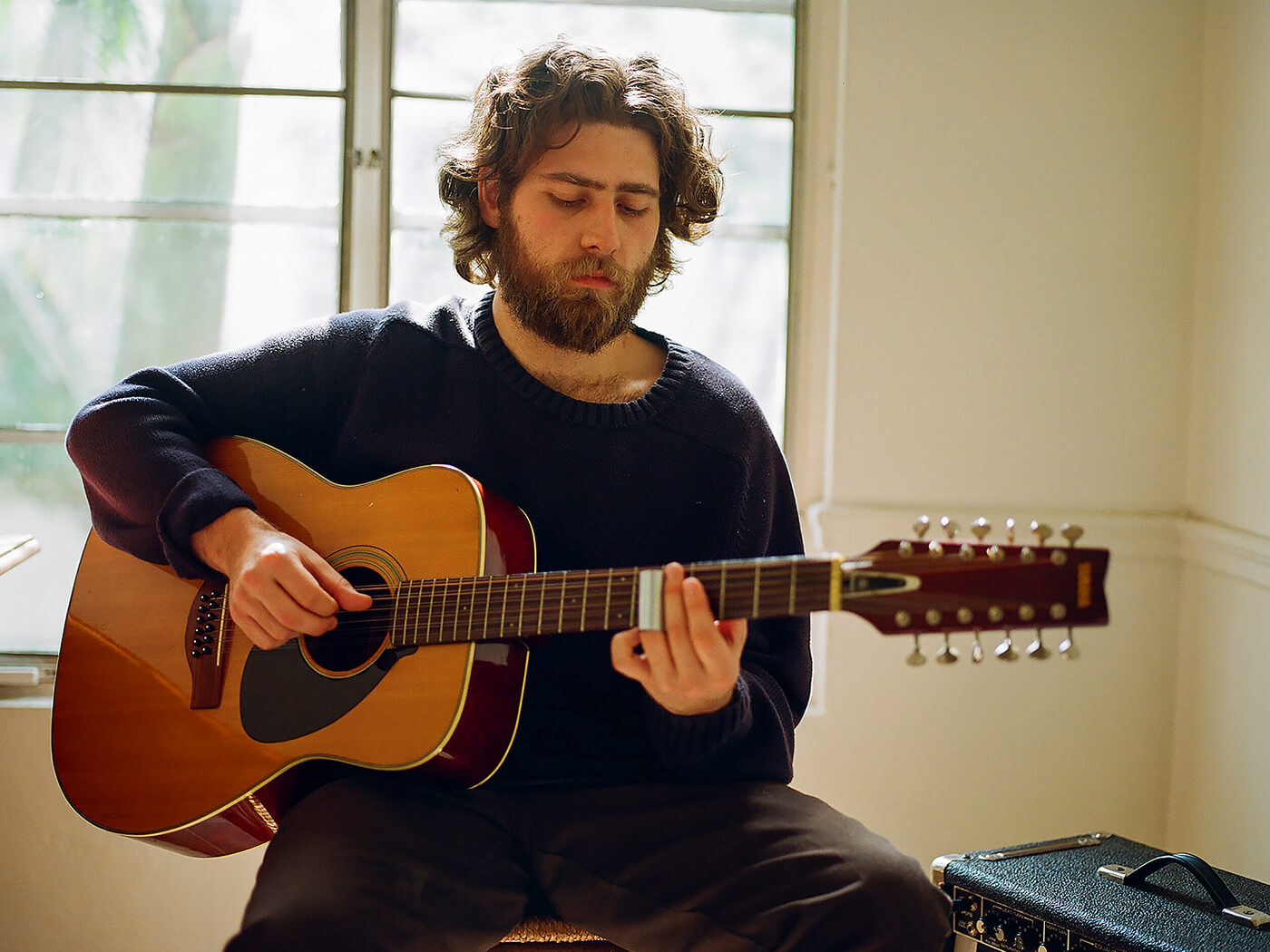
Dylan Day’s gig roster may read like a Who’s Who of popular music – featuring the likes of Jackson Browne, Grace Potter, Jenny Lewis and Beck – but Dylan’s mission isn’t about fame or checking big names off a list. In fact, his outlook on life as a musician in Los Angeles is decidedly unencumbered. “My ideal situation is one where everyone has an open mind and good intentions. Where the larger picture is always seen.”
Hailing originally from Fletcher, Vermont, Dylan’s earliest musical memories revolve around those after-dinner hours when his father would strum a few tunes on his Gibson B-25 to settle in for the evening. Kris Kristofferson and Johnny Cash were old standbys and before too long, he fell in love with music. Bedrock American artists like Brian Blade, Arvo Pärt and Mississippi John Hurt had a huge impact on Dylan’s understanding of songwriting, while Southern gospel and Gaelic music informed his style and sound.
In his teen years, he cut his teeth playing at town meetings and dance halls, later graduating to clubs in New York City and Boston. Eventually, Dylan moved to Los Angeles and started making records and found his stride with a number of like-minded artists, including the stellar names mentioned above.
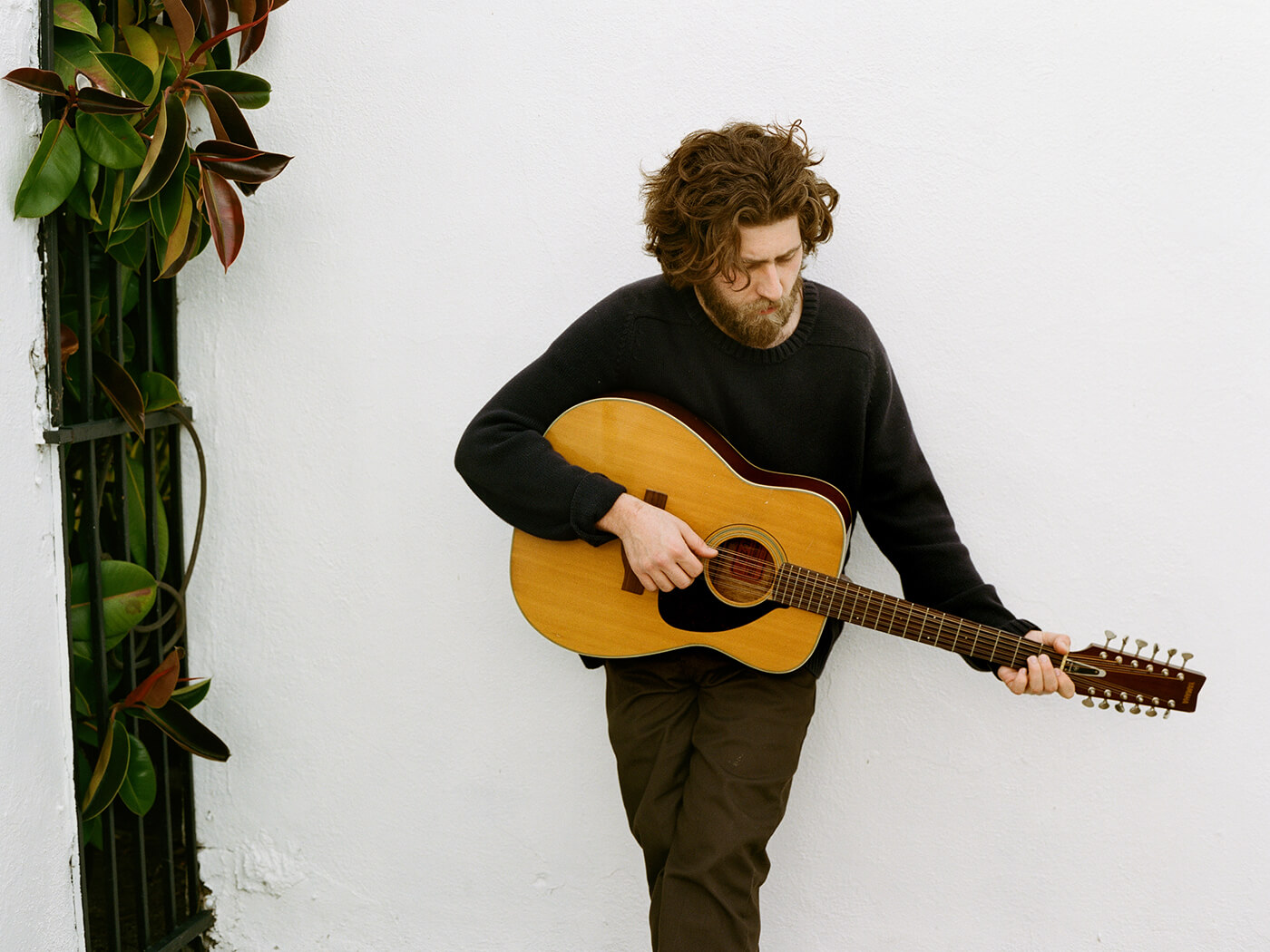
Day tends to gravitate toward open, moody tones – “A halo around the moon,” as he puts it. When asked about gear preferences, he sums up his tastes succinctly in our email correspondence: “1950s electronics and good transformers. Gear that I can turn up and play softly.” While he’s usually strumming a Gibson BB King model or a Gold Foil-equipped Telecaster, Dylan doesn’t actually own much in the way of gear these days. In the process of simplifying his life, he’s elected to jettison most of what he owns and uses whatever tools are available to him at the studio on any given day.
No matter the instrument, his style feels like reading between the lines: Dylan’s sombre, breathy tone lives in the space connecting verses, with wistful peals that break through a melody just long enough to suggest a feeling only to retreat just as quickly as they arrived. With a delicate touch, his laid-back licks hang in the air like jazz-club smoke rings and lifts even the saddest songs with a hopeful, decisive air. ‘Texture’ isn’t quite the right word for it; what he does is more like pressing one’s finger to a mood ring, releasing, then watching as the memory of body heat fade through the spectrum until it’s gone completely.
In most musical situations, Day doesn’t seem to mind what role he plays, only that the work is real and authentic. In the studio, Day looks for conceptual payoffs, mining for sounds and supporting the musical narrative; on stage, he aims for intent and passion. In response to queries about his process, Dylan’s answer is short and sweet: “I do everything I can to lift up the music.”
Currently, Dylan Day can be found on tour with Jenny Lewis, living out his favourite mantra: “Give what you have to give. Every day.”
Harrison Whitford
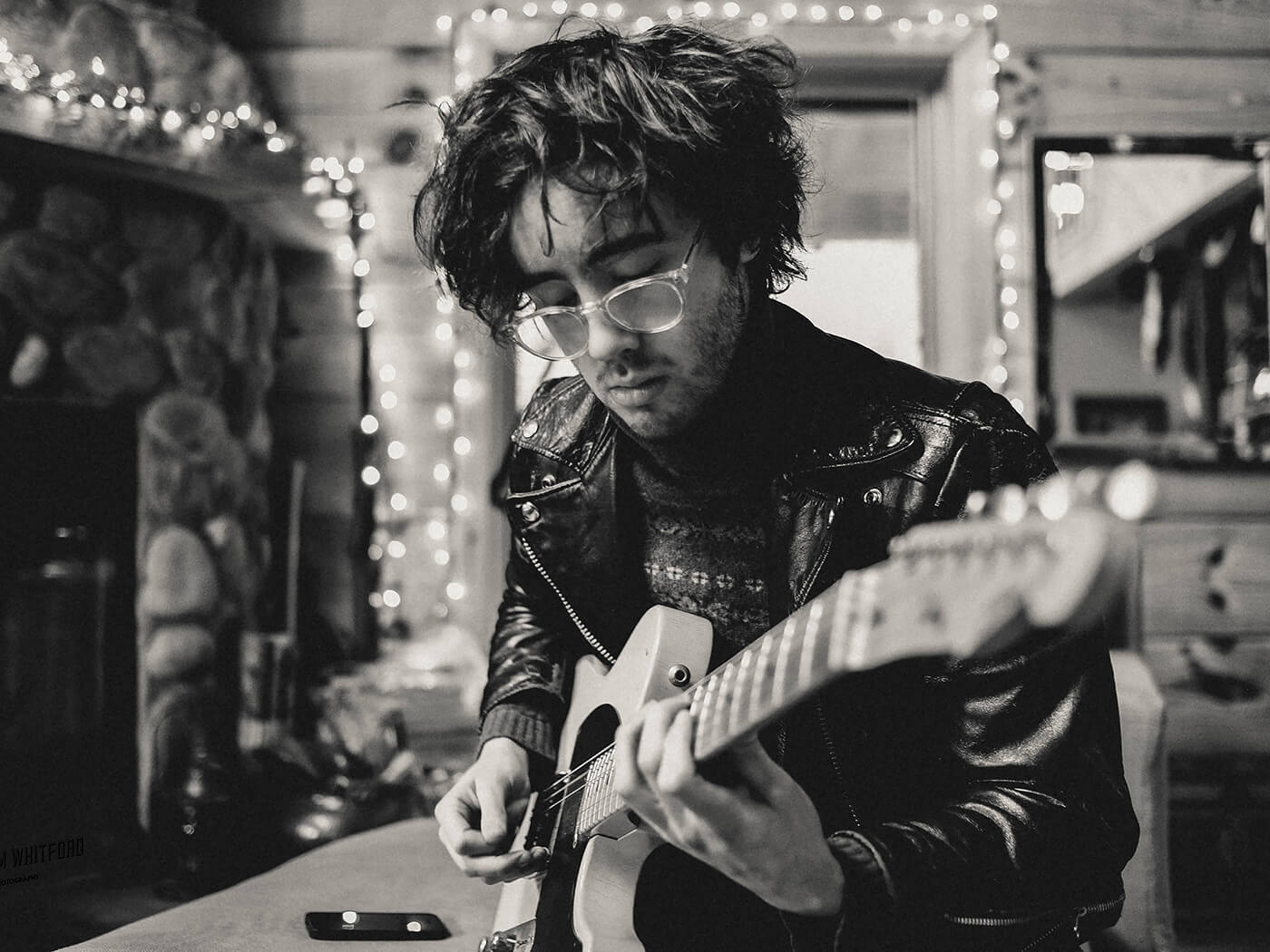
Before we get started, point your phone or computer at YouTube and check out the Pitchfork Live Phoebe Bridgers live session at Brooklyn Steel. At around the 32-minute mark on the track Motion Sickness, the lead guitar plays around and off of Phoebe’s restrained vocals, dancing around the subject matter like a politician embroiled in controversy who refuses to take questions. The debate between vocalist and instrumentalist sparks and settles, then eases back into a familiar blanket of coy jabs that come from a deep and abiding camaraderie.
This is the beauty of Harrison Whitford’s talents: the obvious job of a so-called ‘hired gun’ is to support the artist, but it’s a rare and special treat when one so profoundly enhances and complements the music that the live version feels so refreshing when compared with the already fantastic studio version found on Stranger In The Alps – a reminder that a good song continues to evolve long after the recording process has ceased.
Though he’s clearly an incredibly skilled player, his real gift is in knowing exactly how and when to lay back so that the spotlight always stays on Bridgers’ contemplative, arresting vocals, a skill likely gleaned by virtue of being surrounded by the guitar from an early age. Harrison’s father and brother are also successful musicians in their own right – and it was that family connection which set him on his path. “It was the classic younger-brother scenario: watching my brother play sparked a wealth of admiration for the instrument. I had to do what he did.”
When Harrison picked up the guitar at the age of 12, he was fortunate enough to have access to a number of amazing musicians to trade bars with, including Robert Randolph, Jonny Lang, Hubert Sumlin, Joe Satriani, and Chris Layton. Like a sponge, he soaked up everything he could from them and carried it with him as he defined his own style. “Getting to play with folks of that calibre at an early age taught me so many musical lessons. I think about them every single day. I owe everything I do and know to those cats.”
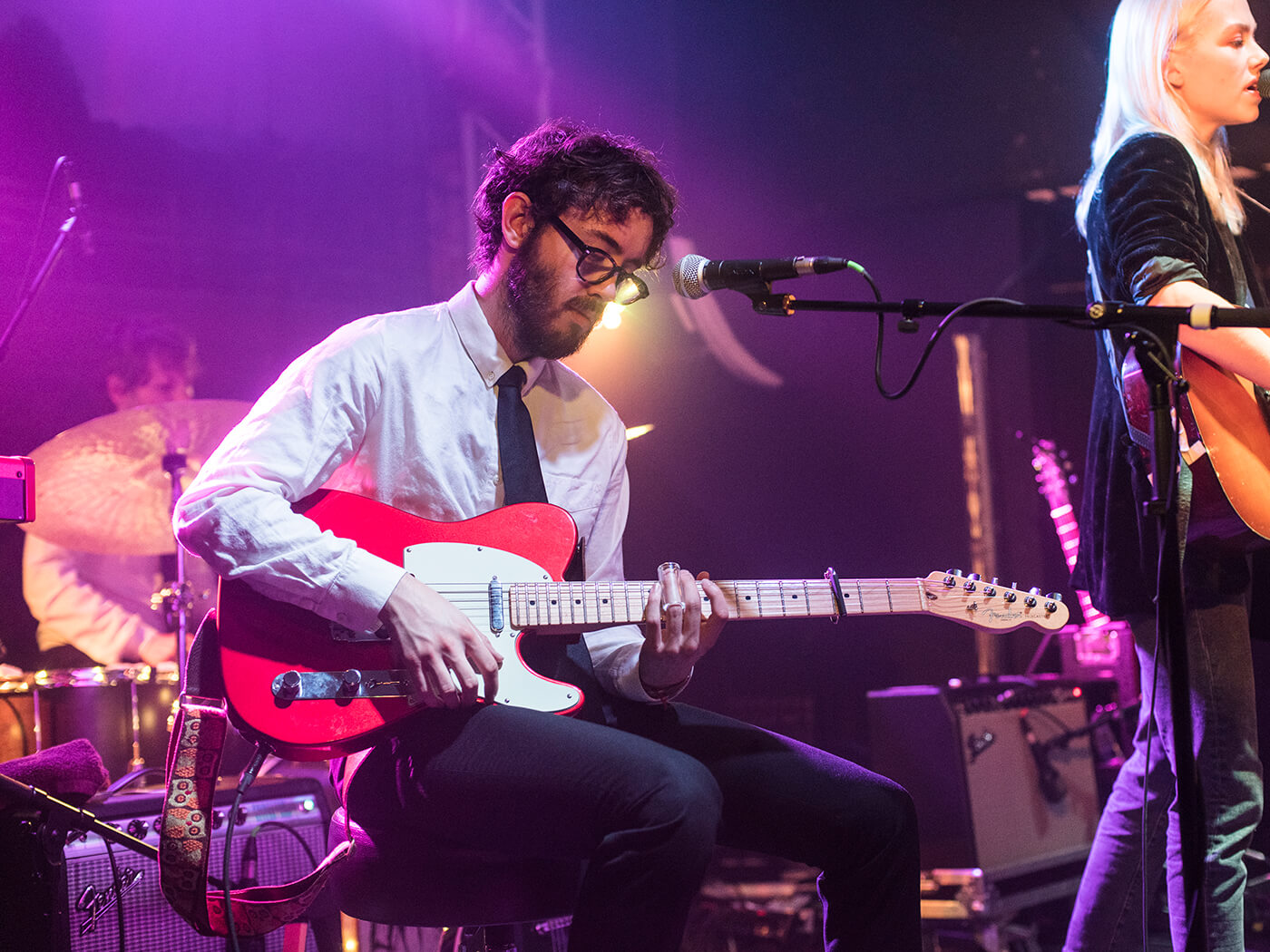
Whitford likens his guitar work to his “chicken scrawl” handwriting, saying, “It always ends up sounding more raw than I intended.” Whether or not it’s on purpose, Harrison’s raw, real sound hits the mark, lending an honest air to whatever he’s working on. Unsurprisingly, honesty is a connecting thread between most of his favourite artists, among which are Paul Westerberg, Neil Young, Joni Mitchell, Ry Cooder, and Tom Waits. “In all of my favourite artists, you can hear their life experience in their work.”
Whether he’s writing on the piano or noodling around on his trusty Sea Foam Green Telecaster, Harrison’s driving philosophy boils down to availability – to the artist, to the session, even to the songwriting muse. In the construction of a song, he says it helps to not get ahead of oneself, to instead be present and let things bloom naturally. “I just try to be a good hang and deliver whatever I can on my instrument. I don’t put too much thought into the end result of things.”
His advice to other LA session hopefuls? Show up. “A huge part of inspiration for me is just showing up everyday. Eventually, you’ll run into a big fish of an idea.” This mindset has been immensely beneficial for him, with studio credits ranging from backing up Willie Nelson, working on an upcoming record with songwriter Johanna Samuels, as well as steady work alongside Phoebe Bridgers over the last six or so years. Whitford’s also hard at work writing the follow-up to his 2018 album debut Afraid Of Everything.
Molly Miller

“It’s an addiction. I’m completely addicted to it.”
For some players, music is just a hobby. For others, it’s a job. For Dr Molly Miller, music is both an obsession and an act of reconciliation. “Whether I’m performing, playing, teaching music, it’s how I can make sense of being a human being in this crazy place.”
Molly, who holds a Doctorate of Musical Arts in Guitar Performance as well as a Master’s in Jazz Studio Guitar, is one of the hardest-working guitarists in the LA scene, known for injecting strident bursts of energy into a track with her unique melodic sense and incredible timing. If you ever have the chance to catch her in action, either with her own Trio or on tour with Jason Mraz, you’ll be hard-pressed to find a more confident and entertaining musician. And that’s to say nothing of her mastery of the musical vocabulary, spoken fluently as a second language. It’s clear that music is very close to her heart, which fits in perfectly with how she first came to the guitar.
Born and raised in Los Angeles as one of five children, Dr Miller found music at an early age – or, rather, it was thrust upon her. At the age of seven, her parents decided to put such a large family to good use and started a band. Molly got picked to be the guitarist of the bunch and soon enough, she was taking the stage at talent shows, street fairs and private parties.
She admits that while the guitar wasn’t initially an interest of hers, it was nonetheless an inescapable part of her childhood. Reflecting on her early introduction to the instrument, Molly confesses that she was a “notoriously bad guitar student” even though music was already such a huge part of her life. It wasn’t until she discovered Jimi Hendrix at 14 that she really started digging in. “I hated practicing guitar in high school, but I learned Purple Haze and it opened up the world.”
Thanks to a stint at Berklee summer camps, Molly finally realised that she wanted to be a musician and hasn’t slowed down since. Unlike players who move to LA from elsewhere and are forced to start from scratch, Molly’s been a known quantity here for years. From the beginning, what she loved most about music was the sense of community, so she naturally and organically built up a network around her as she progressed and gained near-constant work.
“I overbook myself,” she confesses. “I think I spent literally two nights at home this year.” Molly refers to herself as “focused,” and certainly that focus has paid dividends for Miller, who seems endlessly busy between shows with indie-pop outfit Steady Holiday, recording and tour dates with her brother Sammy Miller, as well as an upcoming album and a packed schedule with her own project, the Molly Miller Trio. Miller has also toured frequently with singer-songwriter Jason Mraz over the last two-and-a-half years and for her, the experience has been as illuminating as it has been life-changing.
Comparing it to other jobs, Miller points to the hierarchy as the biggest difference. “It’s hard to play with pop artists and still be able to express yourself, but Jason encourages you to dig into who you are and be that onstage.” In Mraz’s band, authenticity is the name of the game and the way he conducts his life really impacts the rest of the crew.
“It always trickles down from the top. His message is to love and to be kind to one another and he lives and breathes that. It reminds me that everyone has a choice in how they act and how they make others feel.”
When asked about her major influences, Miller excitedly rattles off a host of names including Jimi Hendrix, Sister Rosetta Tharpe, Julian Lage, Blake Mills and Rich Hinman – all of which come out a bit in her unique blend of jazz, funk, blues and country. Her unique instrumental voice, however, is unmistakable: she slings the guitar like a wordsmith, wry and sarcastic with a playful slant and flows from hushed whisper to bursts of elation with aplomb.
Like an accomplished orator, she speaks in complete instrumental sentences, her grammar impeccable, her ideas poignant and compelling. Listen to any of her releases or watch any of her many cover videos on YouTube and you’ll immediately pick up on her mastery of subtle dynamic shifts and ability to meld familiar melodies and blue chords.
Miller typically tours with Gibson instruments, including her trusty ’78 ES-335. She’s also fond of a $900 Shell Pink Telecaster she scored from Craigslist which she simply describes as “super cute”. Miller chooses ultra-dependable Sinasoid cables and often enhances her lush clean tones with pedals from Keeley Electronics and EarthQuaker devices.
Whether she’s playing a $50 bar gig or a world tour, Molly maintains a grateful attitude and seems shocked that she gets to do what she does. “I get to play inspiring music with people who inspire me… I’m living my dream.” That dream also extends to her job at the Los Angeles College of Music, where she serves as head of the Guitar Department. “I have a lot of independence in my position, so I got to rewrite the curriculum. It’s crazy, and it’s scary.”
Even with all of this on her plate, she takes it all in stride and appears to relish the creative act more than anything else. “I love what I do. I play inspiring music with people who inspire me, people I’ve always looked up to. I took lessons from Adam Levy at 18 and now I have a gig with him tomorrow morning.”
Check out more new artists here.
